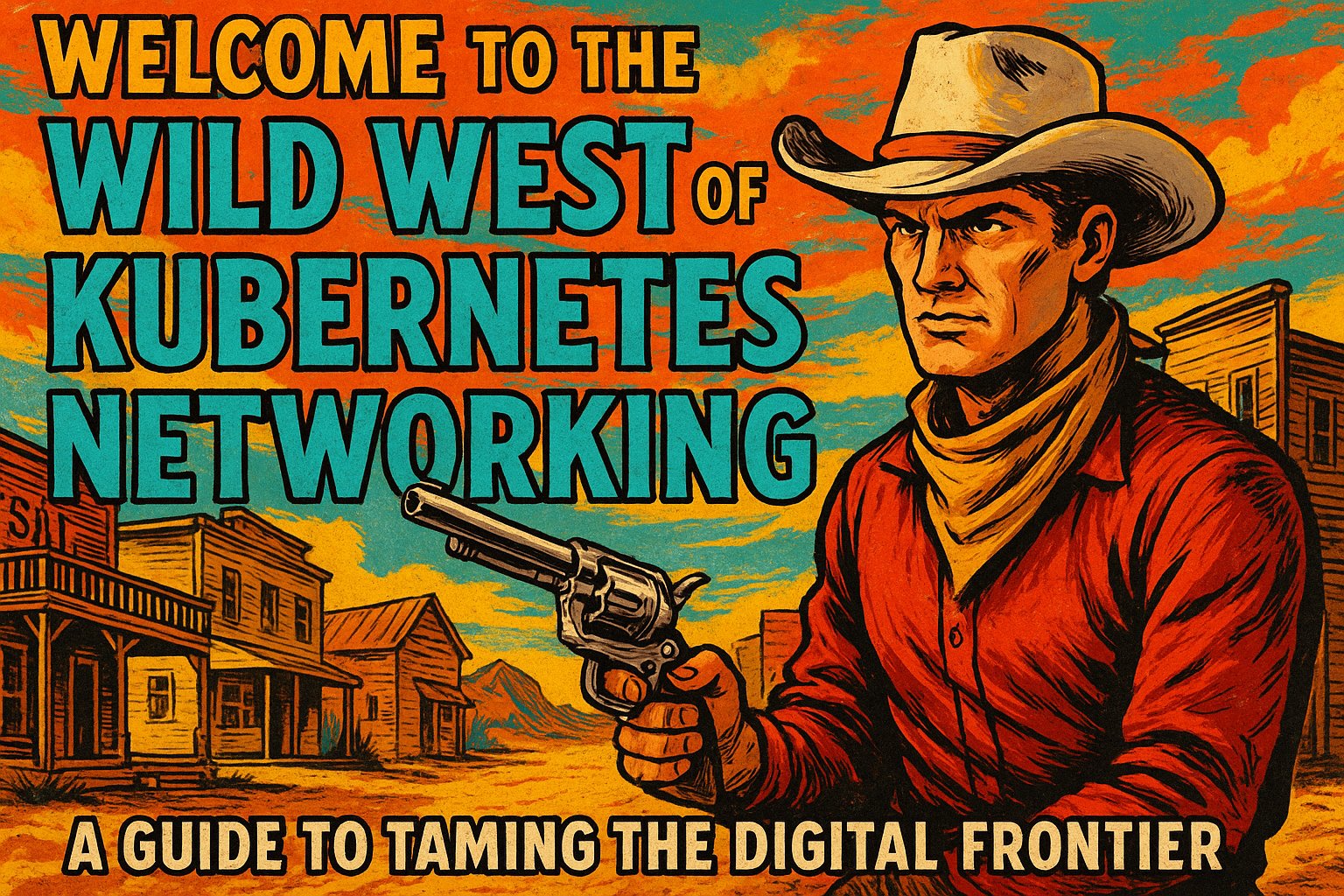Welcome to the Wild West of Kubernetes Networking: A Guide to Taming the Digital Frontier

Kubernetes networking is like trying to organize a massive family reunion where everyone speaks different languages, lives in different time zones, and has strong opinions about how traffic should flow through the party. At its core, Kubernetes networking transforms what could be a chaotic mess of containers into a well-orchestrated symphony of digital communication, where pods chat with each other like old friends and external users can actually find their way to your applications without a GPS.
The Kubernetes Network Model: Building Blocks of Digital Democracy
Think of the Kubernetes Network Model as the constitution of container communication. Just like any good democracy, it establishes fundamental rules that everyone must follow, regardless of their political networking affiliation. The model addresses several orthogonal problems that somehow manage to work together like a surprisingly functional dysfunctional family.
The foundation rests on pod-to-pod communication, where every pod gets its own IP address and can theoretically talk to any other pod in the cluster without needing a translator or mediator. This is wonderfully idealistic, much like believing that all family members will get along at Thanksgiving dinner. Service discovery acts as the digital equivalent of a phone book (remember those?), helping applications find each other in the vast expanse of cluster chaos.
North-South connectivity represents the bridge between your internal cluster world and the scary external internet. This is where LoadBalancer services and Ingress controllers come into play, acting like diplomatic ambassadors who speak both internal container language and external HTTP protocol. The beauty of this architecture is that despite the apparent complexity, each layer builds upon abstractions provided by others, creating a stack that's more stable than a house of cards in a windstorm.
Top 3 Kubernetes Network Model Components:
- Pod-to-Pod Communication - The backbone that makes containers feel like they're all living in the same neighborhood
- Service Discovery - The digital yellow pages that actually works
- North-South Traffic Management - The diplomatic corps that handles foreign relations with the internet
CNI: The Network Plugins That Actually Make Things Work
Container Network Interface (CNI) is where the rubber meets the road in Kubernetes networking. Think of CNI plugins as the plumbing contractors of the container world - they're absolutely essential, nobody really wants to think about them until something breaks, and when they work well, everything flows smoothly.
Every CNI plugin must accomplish two fundamental things: provide connectivity (because isolation is overrated) and ensure reachability (because what good is a container that can't talk to anyone?). The connectivity requirement is straightforward - every pod needs an ethernet interface that can communicate outside its own network namespace. It's like giving every resident in an apartment building their own front door key.
The reachability challenge is where things get interesting. Pods need to reach other pods within the same node's PodCIDR range, connect to pods on different nodes entirely, and somehow make sense of IP allocations managed by the controller-manager. Different CNI plugins solve this puzzle using various approaches - some prefer overlay networks that wrap traffic in additional headers like digital gift wrapping, while others use BGP routing that makes network switches gossip about destinations like a neighborhood watch program.
The CNI ecosystem offers flavors for every networking palate. Flannel provides simplicity for those who prefer vanilla networking, Calico brings network policies and BGP routing for the power users, and Cilium leverages eBPF technology for those who want to feel like they're living in the future. Each plugin has its own personality - some work better in cloud environments, others prefer the predictability of on-premises infrastructure, and a few are picky about Pod network CIDR configurations.
Top 3 CNI Plugins:
- Calico - The reliable workhorse with advanced network policy support and BGP routing capabilities
- Cilium - The modern choice featuring eBPF technology and comprehensive observability features
- Flannel - The simple, lightweight option that just works without overthinking things
Services: The Load Balancing Democracy
Kubernetes Services are like the diplomatic corps of container communication - they provide stable identities for groups of ephemeral pods that come and go like seasonal workers. While pods might disappear and reappear with different IP addresses faster than you can say "rolling update," Services maintain consistent endpoints that applications can rely on.
The ClusterIP service type is the most common and acts like an internal phone exchange, assigning a unique virtual IP to a set of backend pods. When applications want to communicate, they call the ClusterIP number, and the service routes the call to one of the healthy backend pods using destination NAT rules. It's remarkably similar to how old-fashioned telephone operators connected calls, except with more YAML and fewer human operators.
NodePort services build upon ClusterIP functionality by exposing applications on a specific port across all cluster nodes. This approach works like having the same phone number ring at multiple locations - external traffic can hit any cluster node, and as long as the destination port matches the NodePort, it gets forwarded to the right backend pod. While functional, NodePort services can feel a bit primitive in an era where everyone expects sophisticated load balancing.
LoadBalancer services represent the premium tier of external exposure, attracting user traffic with externally routable IP addresses that get advertised to the physical network. These services require external implementation - either cloud provider load balancers or on-premises solutions like MetalLB and kube-vip. The process resembles having a dedicated concierge service that directs visitors to the right apartment in a large building complex.
Top 3 Service Implementation Tools:
- kube-proxy - The default service proxy that makes ClusterIP magic happen through iptables or IPVS
- MetalLB - The go-to LoadBalancer implementation for bare metal clusters using standard routing protocols
- kube-vip - The high-availability solution that provides both control plane VIPs and LoadBalancer services
Ingress and Egress: Managing the Digital Border
Ingress and Egress traffic management in Kubernetes feels like running border control for a very busy digital nation. Ingress represents the revenue-generating foot traffic coming into your cluster applications, while egress handles the less glamorous outbound traffic like DNS queries and package updates that keep the digital infrastructure running smoothly.
The Ingress API was designed as a vendor-independent way to configure HTTP load balancers that multiple Kubernetes applications could share. Rather than requiring each application to bring its own load balancer (which would be like every apartment tenant hiring their own doorman), Ingress controllers provide shared application gateway functionality. The API allows users to define routing rules that direct incoming HTTP requests to appropriate backend services, creating a sophisticated traffic routing system that would make urban planners jealous.
Choosing an Ingress controller can feel overwhelming given the dozen-plus implementations available from major load balancer, proxy, and service mesh vendors. NGINX Ingress Controller leads the popularity contest as the most widely deployed option, offering the reliability of the battle-tested NGINX web server with Kubernetes integration. Traefik brings modern, dynamic configuration with automatic service discovery, while HAProxy Ingress provides enterprise-grade performance for applications that demand reliability.
The implementation landscape includes both open source and commercial options, each with distinct personalities and capabilities. Some focus on simplicity and ease of use, others prioritize advanced features like API management and security, and a few specialize in specific environments like service mesh integration or cloud-native architectures.
Top 3 Ingress Controllers:
- NGINX Ingress Controller - The most popular choice with proven reliability and extensive feature support
- Traefik - The modern, cloud-native option with automatic service discovery and dynamic configuration
- HAProxy Ingress - The performance-focused choice for enterprise applications requiring high reliability
Network Policies: Digital Access Control
Network Policies in Kubernetes function like a sophisticated security system for your digital neighborhood, allowing you to specify exactly how pods can communicate with various network entities. Think of them as creating invisible walls and gates that control traffic flow at the IP address and port level for TCP, UDP, and SCTP protocols, though the behavior for other protocols remains as undefined as your relationship status on social media.
The policy framework operates through three main identifiers: other pods that are allowed to communicate (with the logical exception that pods cannot block access to themselves - even Kubernetes believes in self-love), namespaces that are permitted, and IP blocks that define external communication boundaries. The system works like a club bouncer with a very specific guest list, checking every connection attempt against defined rules.
Network Policy implementation depends entirely on CNI plugin support, making the choice of networking solution critical for security-conscious deployments. Some CNI plugins excel at policy enforcement, while others treat Network Policies like optional suggestions. The specification has evolved to support port ranges, allowing administrators to define policies that cover multiple ports without creating dozens of individual rules.
One particularly interesting aspect of Network Policies involves hostNetwork pods, where behavior remains deliberately undefined. The specification acknowledges that network plugins might handle hostNetwork traffic differently, leading to scenarios where policies either apply consistently or ignore hostNetwork pods entirely. It's like having security rules that might or might not apply to certain VIP guests, depending on which security company you hired.
IPv6: The Future That's Still Arriving
IPv6 support in Kubernetes remains perpetually "under construction" with a help-wanted sign prominently displayed. Like many infrastructure technologies, IPv6 adoption in containerized environments moves at the pace of a careful evolution rather than a revolutionary sprint. The networking guide acknowledges this reality with refreshing honesty, marking the IPv6 section as requiring community assistance.
The challenge with IPv6 in Kubernetes environments stems from the complexity of maintaining dual-stack networking while ensuring backward compatibility with existing IPv4 infrastructure. Many CNI plugins and networking tools have varying levels of IPv6 support, creating a patchwork of compatibility that requires careful planning and testing.
Organizations considering IPv6 deployment in Kubernetes clusters must evaluate their entire networking stack, from CNI plugins and ingress controllers to load balancers and external connectivity. The transition requires coordination between infrastructure teams, application developers, and network administrators to ensure seamless operation across both protocol versions.
DNS: The Digital Phone Book That Actually Works
DNS plays a central role in Kubernetes service discovery, functioning like a remarkably reliable digital phone book that actually gets updated when people move. Unlike the old yellow pages that became obsolete the moment they were printed, Kubernetes DNS maintains real-time accuracy about service locations and availability.
Every Kubernetes service receives at least one corresponding DNS record following the format {service-name}.{namespace}.svc.{cluster-domain}. The response format depends on the service type - ClusterIP services return their virtual IP address, headless services provide a list of endpoint IPs, and ExternalName services return CNAME records pointing to external destinations. It's like having different types of directory listings for different kinds of businesses.
CoreDNS has become the default DNS implementation for Kubernetes clusters, replacing the earlier dnsmasq-based solution. CoreDNS implements the Kubernetes DNS specification through a dedicated plugin compiled into a static binary and deployed as a regular Kubernetes deployment. This approach means that DNS communication follows the same network forwarding rules and limitations as normal pod traffic, creating consistency in how cluster networking operates.
The CoreDNS implementation focuses heavily on performance optimization, storing only relevant portions of Services, Pods, and Endpoints objects in a local cache designed for single-lookup responses. By default, CoreDNS also handles external DNS queries, acting as a proxy for domains outside the cluster and ensuring that applications can resolve both internal service names and external hostnames seamlessly.
Top 3 DNS Implementation Considerations:
- CoreDNS Configuration - The default implementation that provides reliable service discovery with customizable plugins
- DNS Performance Optimization - Caching strategies and query optimization that affect application response times
- External DNS Integration - Ensuring seamless resolution of both cluster-internal and internet-external domain names
Final Thoughts: Embracing the Beautiful Complexity
Kubernetes networking represents one of those rare technological achievements that manages to be simultaneously elegant and complex, like a Swiss watch that happens to also be a spaceship. The beauty lies not in any single component but in how all the pieces work together to create a cohesive system that makes container communication feel almost magical.
The networking ecosystem continues evolving as new technologies like eBPF push the boundaries of what's possible in kernel-space networking, while established solutions like iptables and IPVS maintain their reliability for production workloads. The choice between different CNI plugins, ingress controllers, and load balancing solutions ultimately depends on your specific requirements, infrastructure constraints, and tolerance for bleeding-edge features.
Perhaps the most remarkable aspect of Kubernetes networking is how it transforms what could be an impossibly complex orchestration challenge into a series of well-defined abstractions that mere mortals can understand and operate. Sure, you might occasionally find yourself deep in the weeds of iptables rules or CNI configuration files, but most of the time, the system just works in ways that feel almost too good to be true.
The future of Kubernetes networking looks bright, with continued innovation in areas like service mesh integration, enhanced security policies, and improved observability. As the ecosystem matures, the gap between "it works" and "it works beautifully" continues to narrow, making sophisticated networking accessible to organizations of all sizes and technical sophistication levels.

